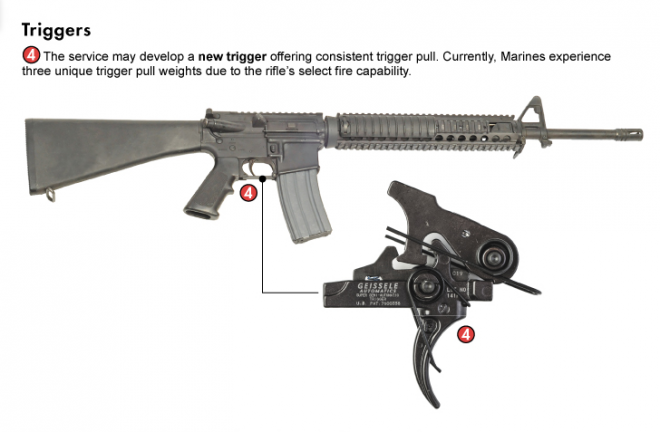MarineTimes reports of a new set of upgrades and enhancements slated to hit USMC M16A4 rifles and M4 carbines over the next few years. The final decision as to exactly what enhancements will be made has not occurred, but a general outline of the improvements desired has been laid down:
MARINE CORPS BASE QUANTICO, Va. – If the Marine Corps’ top marksmanship experts get their way, Marines are going to get a rifle retooled with an array of upgrades that will make them deadlier shooters. They recently directed the study of a number of significant changes to the service’s weapons, ammunition, shooting curriculum and ranges and have approved new competitions.
Most eagerly anticipated are recommendations to study overhauling M16A4 rifles and M4 carbines with a host of new features, including a new trigger and barrel, all of which will be a hot topic at the next Combat Marksmanship Symposium in October.
The lines of pursuit — the product of the this year’s Combat Marksmanship Symposium held here in Quantico — hold a common theme, according to leaders at Weapons Training Battalion Quantico. They are designed to make Marines deadlier in combat and provide them the tools and training to dominate the battlefield whether in the sands of the Middle East or the jungles of the Asia Pacific region.
“I thought the most important thing was not to look at the short term,” said Col. Tim Parker, the commanding officer of WTB Quantico and the Marine Corps’ marksmanship proponent.
“I didn’t want a range or weapon for today. I wanted one for 2050 to 2100. Extrapolating what we have in Expeditionary Force 21, it was about how we fight this century. I want the symposiums looking out further,” he added.
A ‘new’ service rifle
Current M16A4 rifles and M4 carbines could get a significant overhaul with mostly inexpensive components already available to consumers. The upgrades would drastically improve accuracy and function without incurring the expense of procuring an new rifle.
Those updates could include a free-floating barrel, rifle compensators, new reticles for the Rifle Combat Optic, more ambidextrous controls and a new trigger group. With significant advancements in rifle technology for the civilian shooting market over the past two decades, those are all features commonly seen on competition rifles and those carried by elite operators.
It’s a novel and mostly inexpensive approach to improve the tried-and-true inventory of standard service rifles even as defense budgets continue to shrink and the service’s procurement and sustainment programs compete for money. Small arms have often taken a back seat in recent years to big-ticket platforms like the F-35 Joint Strike Fighter, Amphibious Assault Vehicle modernization and the procurement of the next generation ship-to-shore troop transport, the Amphibious Combat Vehicle 1.1.
In 2013, as the military’s manpower drawdown got underway and the services scrambled to realign budgets and personnel, Brig. Gen. William Mullen, head of the Corps’ Capabilities Development Directorate, said small arms were sufficient — even if not ideal. “The weapons we have right now are working pretty good,” he said. “They aren’t perfect. You talk to Marines and get 20 different opinions about our weapons. But they are doing the job.”
But the Corps’ top gunners have an eye toward giving current rifles a makeover that would make them shoot like a next-generation weapon. Over the next seven to eight months they will study proposed upgrades by surveying the commercial market, testing products on the range and estimating potential costs before presenting a recommendation at the next marksmanship symposium. The symposium’s working groups will make final recommendations based on research now underway and hand those to the Corps’ top general, Commandant Joseph Dunford, for a final decision — a process that can take several more months.
The upgrades would include a compensator, free-floated barrel, improved optic based on the M27’s SDO, a more consistent trigger, ambidextrous modifications, the transition entirely to Mk. 318 SOST ammunition for combat, hollow point ammunition for pistols, and a new holster for the pistol.
It’s not clear whether this indicates a that the Marines have forsworn the M855A1 round entirely (last we heard, the Marines were testing the M855A1 and awaiting a final decision).
One of the interesting aspects of this is the lack of an operating rod upgrade for the M16A4 and M4. The Marines now have a few years’ experience with the M27, and many of these upgrades are based on the improvements seen with that rifle, but conspicuously absent is any change to the gas system.
 Your Privacy Choices
Your Privacy Choices
